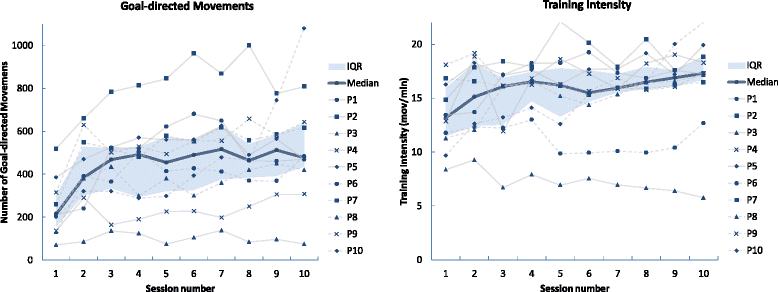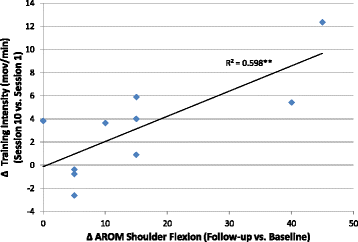Increasing upper limb training intensity in chronic stroke using embodied virtual reality: a pilot study
- PMID: 29149855
- PMCID: PMC5693522
- DOI: 10.1186/s12984-017-0328-9
Increasing upper limb training intensity in chronic stroke using embodied virtual reality: a pilot study
Abstract
Background: Technology-mediated neurorehabilitation is suggested to enhance training intensity and therefore functional gains. Here, we used a novel virtual reality (VR) system for task-specific upper extremity training after stroke. The system offers interactive exercises integrating motor priming techniques and embodied visuomotor feedback. In this pilot study, we examined (i) rehabilitation dose and training intensity, (ii) functional improvements, and (iii) safety and tolerance when exposed to intensive VR rehabilitation.
Methods: Ten outpatient stroke survivors with chronic (>6 months) upper extremity paresis participated in a ten-session VR-based upper limb rehabilitation program (2 sessions/week).
Results: All participants completed all sessions of the treatment. In total, they received a median of 403 min of upper limb therapy, with 290 min of effective training. Within that time, participants performed a median of 4713 goal-directed movements. Importantly, training intensity increased progressively across sessions from 13.2 to 17.3 movements per minute. Clinical measures show that despite being in the chronic phase, where recovery potential is thought to be limited, participants showed a median improvement rate of 5.3% in motor function (Fugl-Meyer Assessment for Upper Extremity; FMA-UE) post intervention compared to baseline, and of 15.4% at one-month follow-up. For three of them, this improvement was clinically significant. A significant improvement in shoulder active range of motion (AROM) was also observed at follow-up. Participants reported very low levels of pain, stress and fatigue following each session of training, indicating that the intensive VR intervention was well tolerated. No severe adverse events were reported. All participants expressed their interest in continuing the intervention at the hospital or even at home, suggesting high levels of adherence and motivation for the provided intervention.
Conclusions: This pilot study showed how a dedicated VR system could deliver high rehabilitation doses and, importantly, intensive training in chronic stroke survivors. FMA-UE and AROM results suggest that task-specific VR training may be beneficial for further functional recovery both in the chronic stage of stroke. Longitudinal studies with higher doses and sample sizes are required to confirm the therapy effectiveness.
Trial registration: This trial was retrospectively registered at ClinicalTrials.gov database (registration number NCT03094650 ) on 14 March 2017.
Keywords: Embodied feedback; Motor rehabilitation; Neurorehabilitation; Rehabilitation dose; Stroke; Training intensity; Virtual reality.
Conflict of interest statement
Ethics approval and consent to participate
The clinical protocol was approved by the Ethical Committee of the Canton Valais (Switzerland). All participants provided their written informed consent prior to enrolment.
Consent for publication
Written informed consent was obtained from the patient in Fig. 1 for use of her image for illustration of the institution and media needs. A copy of the written consent is available for review by the Editor-in-Chief of this journal.
Competing interests
The authors DPM, GG and TT were employees of MindMaze SA at the time of the study.
Publisher’s Note
Springer Nature remains neutral with regard to jurisdictional claims in published maps and institutional affiliations.
Figures



References
-
- Mozaffarian D, Benjamin EJ, Go AS, Arnett DK, Blaha MJ, Cushman M, Das SR, de Ferranti S, Despres JP, Fullerton HJ, et al. Heart disease and stroke Statistics-2016 update: a report from the American Heart Association. Circulation. 2016;133:e38–e60. - PubMed
-
- Winstein CJ, Stein J, Arena R, Bates B, Cherney LR, Cramer SC, Deruyter F, Eng JJ, Fisher B, Harvey RL, et al. Guidelines for adult stroke rehabilitation and recovery: a guideline for healthcare professionals from the American Heart Association/American Stroke Association. Stroke. 2016;47:e98–e169. doi: 10.1161/STR.0000000000000098. - DOI - PubMed
Publication types
MeSH terms
Associated data
LinkOut - more resources
Full Text Sources
Other Literature Sources
Medical

